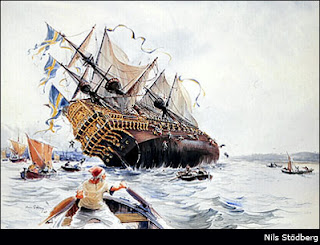THE VASA:
SALVAGING THE WORLD’S LARGEST WOODWORKING BLUNDER
By Spike Carlsen
If you visit the most popular tourist attraction in Sweden,
you won’t find yourself in the midst of an amusement park, strolling through a
20 acre shopping mall or standing atop an 80 story building. No, you’ll find
yourself—as have 25 million other visitors—in a dimly-lit building housing a
ship that sank almost 400 years ago. It may sound a bit ho-hum, but if you like
woodworking, you’ll love the stories behind the building, launching and
restoration of this incredible war ship.
The
short version of this long tale goes like this: In 1628 the Vasa, intended to
be the premier warship of its day, was launched in Stockholm harbor. It’s
double-decker construction was intended to give it the upper hand in battle;
the tallest ship, since it can shoot down on the decks of shorter ships, could
command the seas. Its double-decker construction also made it a wee bit top
heavy.
But
what made this ship truly unique was its ornamentation. Over 500 wood
sculptures—depicting Greek and Roman rulers, mermaids, sea monsters, lions,
biblical characters and, of course, Swedish Kings—decorated the boat. It took
six sculptors along with teams of apprentices over two years to craft just the
sculptures.It was a riot of colors.
Much of the other ornamentation is equally impressive. Many considered
it “a floating work of art.”
The
ship set sail on its maiden voyage in 1628. It traveled a few hundred yards,
opened its gun ports to fire the traditional salute, caught a not-so-strong
gust of wind, healed to port, took water in through its open gun ports, then
sank before the unbelieving eyes of the thousands of spectators lining the
shore. It’s surmised that converting the ship to a double decker design after
construction had begun coupled with a lack of ballast caused the disaster.

After
sitting on the bottom of the harbor for 333 years, the ship was raised. (I
cover the story more thoroughly in my book, A Splintered History of Wood: Belt
Sander Races, Blind Woodworkers and Baseball Bats.) The ship was raised to the
surface in 1960 (a story in and of itself) and a heroic restoration effort was
begun. It required the fitting together of over 13,000 pieces that had
separated or fragmented over the years. Five hundred sprinkler heads sprayed
polyethylene glycol (PEG) over the hull at 45 minute intervals to replace the
water as the ship dried out.
And today the Vasa is a thing of unbelievable
splendor—to woodworkers and non-woodworkers alike.
I
left the museum with two woodworking notions in the back of my mind. The first
had to do with the remarkable craftsmanship displayed, despite the builders
having only rudimentary tools and crude plans to work with. The second has to
do with my own woodworking prowess. The next time I slip up making a dado or
dovetail, I won’t despair. I’ll just think about the Vasa—the biggest
woodworking blunder of all time. I’ll just yell out, “Whoops—I just made a
Vasa.”
+WW+FAQ+front+cover+jpeg.jpg)
